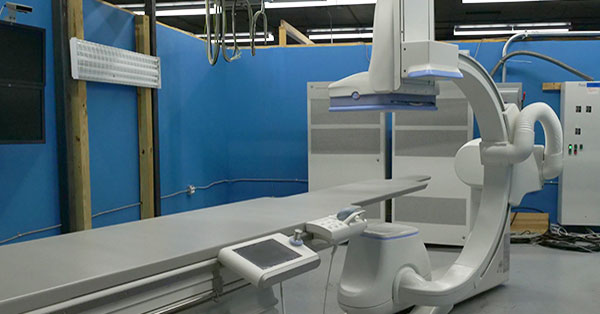
Whether you have an existing office-based lab (OBL), or you are looking to start a new one, one of the biggest decisions you’ll have to make is which imaging equipment your physicians will use. There's a lot to consider, not the least of which is whether you'll be best served by a cath lab or by a C-arm.
To help you in making that decision, we compare the two modalities below to highlight their separate strengths and provide some insight on what kind(s) of work each is better suited for.
Why Should I Choose a Cath Lab?
If You Need More Power
A cath lab has much more power to handle heavier case loads, longer studies, and larger patients. The generator in a cath lab typically has an output of 85-100kW, while a C-arm generator is in the 7.5-25kW range.
Workflow Features
Being a fully integrated system, a cath lab has a whole host of features to make imaging during surgery easier and more efficient; multiple table-side controls, a motorized table, post-processing workstation options, and more. Each of these features helps provide positioning and visibility for any need.
Flexibility
With the articulated overhead monitor suspension and a table-side controlled gantry, it is easy to move components around to make workflows more comfortable for everyone. This can be done with a C-arm as well, but sometimes requires physically moving the whole system.
Why Should I Choose a C-Arm?
Less Involved Procedures
While the "bells and whistles" of a cath lab may be enticing, your particular specialty may not necessarily benefit from them. Take pain management, for example. If pain management procedures are going to be your bread and butter, you won't even use many of the features on a cath lab- so why pay for them?
Acquisition and Ongoing Service costs
There’s no arguing it, the acquisition costs for a C-arm are going to be much lower than that of a cath lab. Accordingly, the ongoing service costs for a C-arm are going to be much less than that the service costs for a cath lab
Logistical Costs
The installation for a C-arm is essentially rolling it into the procedure room and plugging it in. A cath lab will likely require full specification drawings and a general contractor to coordinate various trades including lead shielding, electrical, HVAC, IT, and more. If your area of specialty calls for the power and features of a cath lab, be sure to include substantial padding in your budget to cover the cost of preparing your facility.
Space
Square footage in facilities is always at a premium. If your procedural workload has you on the fence, the smaller room size requirements for a C-arm could make the decision for you.
The Takeaway
Regardless of which direction you decide to go, we’re happy to answer any question you might have and help you make the best decision for your practice. If you’d like to learn more about either modality, our cath lab and C-arm e-guides are available for download, and we’re always available to discuss as well. Contact us today and so we can connect on your particular project!

Kenn Dextrom
Kenn Dextrom is the Director of Product Manager at Block Imaging. He aims to provide clear direction and careful planning for Interventional Cath Lab buyers and working with the Block Imaging product team to provide excellent solutions for our customers. Out of the office, he spends most of his time keeping up with his wife and their three energetic sons.






